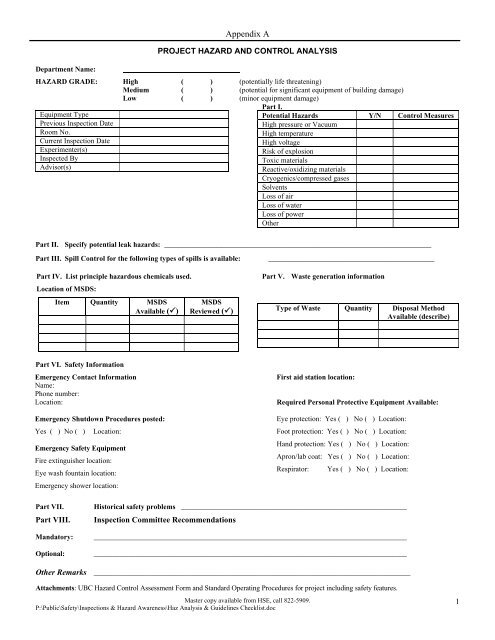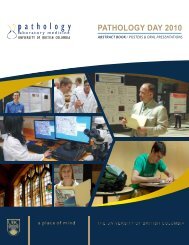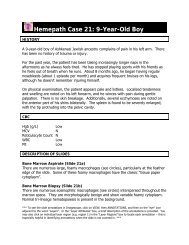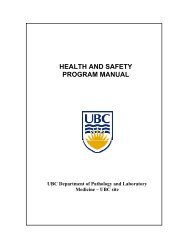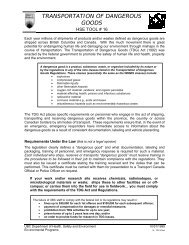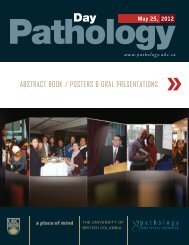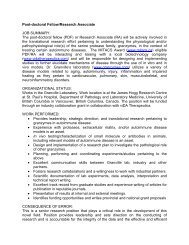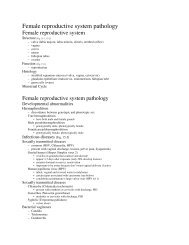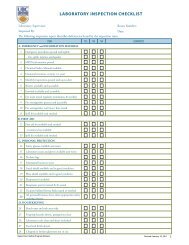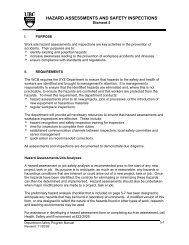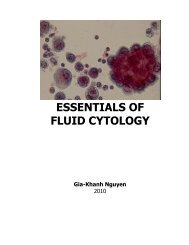Appendix A - Pathology and Laboratory Medicine
Appendix A - Pathology and Laboratory Medicine
Appendix A - Pathology and Laboratory Medicine
Create successful ePaper yourself
Turn your PDF publications into a flip-book with our unique Google optimized e-Paper software.
<strong>Appendix</strong> APROJECT HAZARD AND CONTROL ANALYSISDepartment Name:HAZARD GRADE: High ( ) (potentially life threatening)Medium ( ) (potential for significant equipment of building damage)Low ( ) (minor equipment damage)Equipment TypePrevious Inspection DateRoom No.Current Inspection DateExperimenter(s)Inspected ByAdvisor(s)Part I.Potential Hazards Y/N Control MeasuresHigh pressure or VacuumHigh temperatureHigh voltageRisk of explosionToxic materialsReactive/oxidizing materialsCryogenics/compressed gasesSolventsLoss of airLoss of waterLoss of powerOtherPart II. Specify potential leak hazards: __________________________________________________________________Part III. Spill Control for the following types of spills is available:_________________________________________Part IV. List principle hazardous chemicals used.Location of MSDS:Item Quantity MSDSAvailable ()MSDSReviewed ()Part V. Waste generation informationType of Waste Quantity Disposal MethodAvailable (describe)Part VI. Safety InformationEmergency Contact InformationName:Phone number:Location:Emergency Shutdown Procedures posted:Yes ( ) No ( ) Location:Emergency Safety EquipmentFire extinguisher location:Eye wash fountain location:Emergency shower location:First aid station location:Required Personal Protective Equipment Available:Eye protection: Yes ( ) No ( ) Location:Foot protection: Yes ( ) No ( ) Location:H<strong>and</strong> protection: Yes ( ) No ( ) Location:Apron/lab coat: Yes ( ) No ( ) Location:Respirator: Yes ( ) No ( ) Location:Part VII.Part VIII.M<strong>and</strong>atory:Optional:Historical safety problems ______________________________________________________________Inspection Committee Recommendations______________________________________________________________________________________________________________________________________________________________________________Other Remarks _______________________________________________________________________________________Attachments: UBC Hazard Control Assessment Form <strong>and</strong> St<strong>and</strong>ard Operating Procedures for project including safety features.Master copy available from HSE, call 822-5909.P:\Public\Safety\Inspections & Hazard Awareness\Haz Analysis & Guidelines Checklist.doc1
UBC HAZARD CONTROL ASSESSMENT GUIDEIf a hazard exists, there is a means of controlling it.There are four (4) types of controls to evaluate in the order given: a) elimination or substitution; b) engineering controls; c) administrative (e.g.procedures, posters, work schedule, etc.); <strong>and</strong> d) personal protective equipment.Note: Reference to procedures means specific procedures for materials/equipment/processes being used <strong>and</strong> includes relevant training.- Legend for abbreviations at end of table on page 2Type of Hazard1. Hazardous materials used <strong>and</strong> stored- hazards identified (e.g. flammability,toxicity, reactivity)- Potential significant inhalation exposuresassessedUBC Procedure orRelevant Reg.BC WCB OccupationalHealth <strong>and</strong> SafetyRegulation (WCBOHSR); WHMIS; BCFire Code; UBC<strong>Laboratory</strong> ChemicalSafety Course Manual2. Compressed gas used or stored BC WCB OHSR; BCFire Code; BC GasSafety Act3. Potentially violent reaction via:- Rapid decomposition- Impact sensitivity- Instability on storage to cold, heat, light,water, metals, etc.- Mischarge or wrong addition order- Quantity <strong>and</strong> rate of evolution of heat <strong>and</strong>gases- water or air contact4. Radioactive material(s) or source(s)used?5. Infectious or biohazardous material(s)used or h<strong>and</strong>led?6. Catalysts, inhibitors, or contaminants(like iron) affect reactions?WCB OHSRCNSC Regulations ; BCWCB OHSR; UBCRadionuclide Safety <strong>and</strong>Methodology CourseManualBC WCB OHSR;WHMIS; CIHRGuidelines; UBCBiosafety ManualBC WCB OHSR;WHMISHazard Control- Substitute/minimize- Use of fume hoods- Install monitoring <strong>and</strong> alarm equipment- Use of appropriate containers & storage units;- Use of appropriate labels & MSDS available(WHMIS)- Develop appropriate h<strong>and</strong>ling, disposal <strong>and</strong>emergency procedures- Develop appropriate signage <strong>and</strong> training procedures- Use of appropriate PPE- Use minimum quantities in lab or shop- Use appropriate means for securing <strong>and</strong> transporting- Install monitors, alarms <strong>and</strong> signage as required- Develop written work <strong>and</strong> emergency procedures;- Ensure appropriate training is conducted- Use of fume hoods- Minimize quantities used; heat generated; othervariables- Isolate or shield areas- Develop means of pressure relief- Use of redundant controls; automatic shutdownmechanism- Develop procedures to vent all parts of system beforebreaking any lines- Use of appropriate storage areas- Develop appropriate h<strong>and</strong>ling & emergencyprocedures- Use of appropriate PPE- Use of fume hoods- Follow CNSC procedures- Follow UBC Radionuclide Safety <strong>and</strong> MethodologyCourse procedures- Develop appropriate emergency procedures- Use of appropriate PPE- Use of Biosafety cabinets <strong>and</strong> fume hoods- Develop appropriate medical surveillance protocols- Follow UBC protocols & procedures includingemergency procedures- Use of appropriate PPE- Use of engineering controls- Develop appropriate h<strong>and</strong>ling procedures- Develop written procedures & training- Develop appropriate emergency proceduresPlease call HSE @ 604-822-5909 to obtain the electronic version of this form. 2P:\Public\Safety\Inspections & Hazard Awareness\Haz Analysis & Guidelines Checklist.doc
<strong>Appendix</strong> AType of Hazard7. Energy Sources/Failures- Heating/cooling systems- Power ( high voltage)- Machinery- Water; air- Ventilation- Automatic controls or equipment- Pressure- Materials/equipment/container integrity8. Possible generation of :- Unacceptable odour- Air pollution,- Excessive noise,- Excessive heat,- Sewer contaminationUBC Procedure orRelevant Reg.BC WCB OHSR; UBCLock-Out procedures; BCElectrical Code; BCBoiler & Pressure VesselCodeWCB OHSR; BC SpecialWaste & otherEnvironmentalRegulations9. Hazardous waste(s) generated BC WCB OHSR; BCSpecial Waste & otherEnvironmentalRegulations10. Potential for impact of hazards ofmaterials <strong>and</strong> process upset onneighbours, service, medical,emergency response personnel, etc.11. Space for equipment, materials <strong>and</strong>experimental set-ups12. Asbestos-containing materialpresent.BC WCB OHSR; BCEnvironmentalLegislationBC WCB OHSRBC WCB OHSR; UBCasbestos h<strong>and</strong>lingproceduresHazard Control- Use of automatic shut-off system for:- power- temperature- HVAC; ventilation;- pressure,- water <strong>and</strong> air supply systems (back-up system)- Use of appropriate signage- Use of lock-out procedures- Develop appropriate h<strong>and</strong>ling & emergencyprocedures for fires/explosions <strong>and</strong> spills- Consider substitution of hazardous materials- Use of engineering controls:- fume hoods- PPE- trap or back-flow preventor (1-way valve)- Use of noise testing <strong>and</strong> absorption materials- Use of a cooling system- Use of a waste trap- Develop appropriate emergency procedures- Use of appropriate containers for storage- Develop written procedures & training- Develop appropriate emergency procedures- Notification of relevant personnel & organizationsprior to incident- Develop process for notification of relevant personnel& organizations post-incident- Develop appropriate emergency procedures- Create adequate <strong>and</strong> appropriate space- Conduct awareness training- Develop reporting procedures- Develop removal/substitution measuresLegend:- BC = British Columbia- WCB = Workers’ Compensation Board- WHMIS =- Workplace Hazardous Materials Information System- PPE = Personal protective equipment- CNSC = Canadian Nuclear Safety Commission- CIHR = Canadian Institutes of Health Research- GVRD = Greater Vancouver Regional District- OHSR = Occupational Health & Safety RegulationMaster copy available from HSE, call 822-5909.P:\Public\Safety\Inspections & Hazard Awareness\Haz Analysis & Guidelines Checklist.doc3


